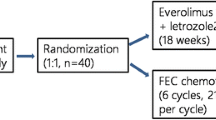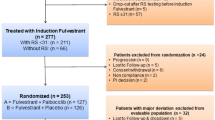Abstract
Purpose
Neo-ALL-IN (NCT 01275859) is a single-center, phase II study aimed to evaluate the efficacy and safety profiles of neoadjuvant letrozole plus lapatinib, as well as potential biomarkers, in postmenopausal women with ER- and HER2-positive (ER+HER2+) breast cancer.
Methods
Postmenopausal ER+HER2+ breast cancer of stages II–III was eligible. Daily 2.5 mg letrozole plus 1500 mg lapatinib were administered for 18–21 weeks before surgery. Clinical responses were assessed by palpation with caliper, breast ultrasonography, mammogram, and/or MRI. Biologic samples were collected for biomarker analyses at three time points (baseline, day 14, and before surgery). Baseline fluorine-18 fluorodeoxyglucose and fluorine-18 fluoroestradiol PET-CT scans were performed.
Results
Among 24 patients enrolled, 17 (70.8 %) completed planned neoadjuvant treatment, whereas 7 prematurely terminated the treatment and proceeded to surgery because of toxicity or progression; 2 patients showed definite progression, and 2 showed clinical regrowth by palpation regardless of minimal response. All patients eventually underwent breast cancer surgery. Toxicities were generally mild mostly within grades 1–2 except prolonged or recurrent grade 3 liver toxicities in 3 patients (13.6 %) regardless of sequential dose reduction, which finally led to discontinuation of treatment. The overall clinical response rates were 62.5 % (n = 15) including 1 CR in breast. However, no pathologic CR (ypT0–is N0) was achieved. SUVmax lower than 5.5 in baseline FES PET-CT (p = 0.007), baseline TILs over 20 % (p = 0.026), and decreased IHC ER Allred score after neoadjuvant treatment (p = 0.021) were significantly associated with adverse clinical response.
Conclusions
When this chemo-free, combination neoadjuvant therapy with letrozole and lapatinib is given for Asian postmenopausal ER+HER2+ breast cancer, TILs, change of ER expression following neoadjuvant treatment, and SUVmax in baseline FES-PET are to be considered potential biomarkers in these patients.



Similar content being viewed by others
References
Mauriac L, MacGrogan G, Avril A et al (1999) Neoadjuvant chemotherapy for operable breast carcinoma larger than 3 cm: a unicentre randomized trial with a 124-month median follow-up. Institut Bergonie Bordeaux Groupe Sein (IBBGS). Ann Oncol 10:47–52
Nicholson RI, Hutcheson IR, Knowlden JM et al (2004) Nonendocrine pathways and endocrine resistance: observations with antiestrogens and signal transduction inhibitors in combination. Clin Cancer Res 10:346S–354S
Carlson RW, O’Neill A, Vidaurre T et al (2012) A randomized trial of combination anastrozole plus gefitinib and of combination fulvestrant plus gefitinib in the treatment of postmenopausal women with hormone receptor positive metastatic breast cancer. Breast Cancer Res Treat 133:1049–1056
Cristofanilli M, Valero V, Mangalik A et al (2010) Phase II, randomized trial to compare anastrozole combined with gefitinib or placebo in postmenopausal women with hormone receptor-positive metastatic breast cancer. Clin Cancer Res 16:1904–1914
Polychronis A, Sinnett HD, Hadjiminas D et al (2005) Preoperative gefitinib versus gefitinib and anastrozole in postmenopausal patients with oestrogen-receptor positive and epidermal-growth-factor-receptor-positive primary breast cancer: a double-blind placebo-controlled phase II randomised trial. Lancet Oncol 6:383–391
Smith IE, Walsh G, Skene A et al (2007) A phase II placebo-controlled trial of neoadjuvant anastrozole alone or with gefitinib in early breast cancer. J Clin Oncol 25:3816–3822
Wu VS, Kanaya N, Lo C et al (2015) From bench to bedside: What do we know about hormone receptor-positive and human epidermal growth factor receptor 2-positive breast cancer? J Steroid Biochem Mol Biol. doi:10.1016/j.jsbmb.2015.05.005
Howlader N, Altekruse SF, Li CI et al. (2014) US incidence of breast cancer subtypes defined by joint hormone receptor and HER2 status. J Natl Cancer Inst 106:1–8
Ellis MJ, Coop A, Singh B et al (2001) Letrozole is more effective neoadjuvant endocrine therapy than tamoxifen for ErbB-1- and/or ErbB-2-positive, estrogen receptor-positive primary breast cancer: evidence from a phase III randomized trial. J Clin Oncol 19:3808–3816
Rimawi MF, Mayer IA, Forero A et al (2013) Multicenter phase II study of neoadjuvant lapatinib and trastuzumab with hormonal therapy and without chemotherapy in patients with human epidermal growth factor receptor 2-overexpressing breast cancer: TBCRC 006. J Clin Oncol 31:1726–1731
Baselga J, Bradbury I, Eidtmann H et al (2012) Lapatinib with trastuzumab for HER2-positive early breast cancer (NeoALTTO): a randomised, open-label, multicentre, phase 3 trial. Lancet 379:633–640
Johnston S, Pippen J Jr, Pivot X et al (2009) Lapatinib combined with letrozole versus letrozole and placebo as first-line therapy for postmenopausal hormone receptor-positive metastatic breast cancer. J Clin Oncol 27:5538–5546
Esserman LJ, Berry DA, DeMichele A et al (2012) Pathologic complete response predicts recurrence-free survival more effectively by cancer subset: results from the I-SPY 1 TRIAL–CALGB 150007/150012, ACRIN 6657. J Clin Oncol 30:3242–3249
Robidoux A, Tang G, Rastogi P et al (2013) Lapatinib as a component of neoadjuvant therapy for HER2-positive operable breast cancer (NSABP protocol B-41): an open-label, randomised phase 3 trial. Lancet Oncol 14:1183–1192
Gianni L, Pienkowski T, Im YH et al (2012) Efficacy and safety of neoadjuvant pertuzumab and trastuzumab in women with locally advanced, inflammatory, or early HER2-positive breast cancer (NeoSphere): a randomised multicentre, open-label, phase 2 trial. Lancet Oncol 13:25–32
Gianni L, Eiermann W, Semiglazov V et al (2014) Neoadjuvant and adjuvant trastuzumab in patients with HER2-positive locally advanced breast cancer (NOAH): follow-up of a randomised controlled superiority trial with a parallel HER2-negative cohort. Lancet Oncol 15:640–647
Shankar LK, Hoffman JM, Bacharach S et al (2006) Consensus recommendations for the use of 18F-FDG PET as an indicator of therapeutic response in patients in National Cancer Institute Trials. J Nucl Med 47:1059–1066
de Azambuja E, Holmes AP, Piccart-Gebhart M et al (2014) Lapatinib with trastuzumab for HER2-positive early breast cancer (NeoALTTO): survival outcomes of a randomised, open-label, multicentre, phase 3 trial and their association with pathological complete response. Lancet Oncol 15:1137–1146
Mahmoud SM, Paish EC, Powe DG et al (2011) Tumor-infiltrating CD8+ lymphocytes predict clinical outcome in breast cancer. J Clin Oncol 29:1949–1955
Loi S, Sirtaine N, Piette F et al (2013) Prognostic and predictive value of tumor-infiltrating lymphocytes in a phase III randomized adjuvant breast cancer trial in node-positive breast cancer comparing the addition of docetaxel to doxorubicin with doxorubicin-based chemotherapy: BIG 02-98. J Clin Oncol 31:860–867
Seo AN, Lee HJ, Kim EJ et al (2013) Tumour-infiltrating CD8+ lymphocytes as an independent predictive factor for pathological complete response to primary systemic therapy in breast cancer. Br J Cancer 109:2705–2713
Melichar B, Studentova H, Kalabova H et al (2014) Predictive and prognostic significance of tumor-infiltrating lymphocytes in patients with breast cancer treated with neoadjuvant systemic therapy. Anticancer Res 34:1115–1125
Salgado R, Denkert C, Campbell C et al (2015) Tumor-infiltrating lymphocytes and associations with pathological complete response and event-free survival in HER2-positive early-stage breast cancer treated with lapatinib and trastuzumab: a secondary analysis of the NeoALTTO trial. JAMA Oncol 1:448–454
Loi S, Michiels S, Salgado R et al (2014) Tumor infiltrating lymphocytes are prognostic in triple negative breast cancer and predictive for trastuzumab benefit in early breast cancer: results from the FinHER trial. Ann Oncol 25:1544–1550
Lee HJ, Kim JY, Park IA et al (2015) Prognostic significance of tumor-infiltrating lymphocytes and the tertiary lymphoid structures in HER2-positive breast cancer treated with adjuvant trastuzumab. Am J Clin Pathol 144:278–288
Denkert C, Loibl S, Noske A et al (2010) Tumor-associated lymphocytes as an independent predictor of response to neoadjuvant chemotherapy in breast cancer. J Clin Oncol 28:105–113
Baker K, Lachapelle J, Zlobec I et al (2011) Prognostic significance of CD8+ T lymphocytes in breast cancer depends upon both oestrogen receptor status and histological grade. Histopathology 58:1107–1116
Lee HJ, Song IH, Seo AN et al (2015) Correlations between molecular subtypes and pathologic response patterns of breast cancers after neoadjuvant chemotherapy. Ann Surg Oncol 22:392–400
Yoshida Y, Kurokawa T, Tsujikawa T et al (2009) Positron emission tomography in ovarian cancer: 18F-deoxy-glucose and 16alpha-18F-fluoro-17beta-estradiol PET. J Ovarian Res 2:1757–2215
van Kruchten M, Glaudemans AW, de Vries EF et al (2015) Positron emission tomography of tumour [F]fluoroestradiol uptake in patients with acquired hormone-resistant metastatic breast cancer prior to oestradiol therapy. Eur J Nucl Med Mol Imaging 20:20
Peterson LM, Kurland BF, Schubert EK et al (2014) A phase 2 study of 16alpha-[18F]-fluoro-17beta-estradiol positron emission tomography (FES-PET) as a marker of hormone sensitivity in metastatic breast cancer (MBC). Mol Imaging Biol 16:431–440
Coudert B, Pierga JY, Mouret-Reynier MA et al (2014) Use of [(18)F]-FDG PET to predict response to neoadjuvant trastuzumab and docetaxel in patients with HER2-positive breast cancer, and addition of bevacizumab to neoadjuvant trastuzumab and docetaxel in [(18)F]-FDG PET-predicted non-responders (AVATAXHER): an open-label, randomised phase 2 trial. Lancet Oncol 15:1493–1502
Yang Z, Sun Y, Xue J et al. (2013) Can positron emission tomography/computed tomography with the dual tracers fluorine-18 fluoroestradiol and fluorodeoxyglucose predict neoadjuvant chemotherapy response of breast cancer?—A pilot study. PLoS One 8:1–7
Talbot JN, Gligorov J, Nataf V et al (2015) Current applications of PET imaging of sex hormone receptors with a fluorinated analogue of estradiol or of testosterone. Q J Nucl Med Mol Imaging 59:4–17
Chen S, Chen CM, Yu KD et al (2012) Prognostic value of a positive-to-negative change in hormone receptor status after neoadjuvant chemotherapy in patients with hormone receptor-positive breast cancer. Ann Surg Oncol 19:3002–3011
Cui X, Schiff R, Arpino G et al (2005) Biology of progesterone receptor loss in breast cancer and its implications for endocrine therapy. J Clin Oncol 23:7721–7735
Arpino G, Wiechmann L, Osborne CK, Schiff R (2008) Crosstalk between the estrogen receptor and the HER tyrosine kinase receptor family: molecular mechanism and clinical implications for endocrine therapy resistance. Endocr Rev 29:217–233
Clark GM, McGuire WL, Hubay CA et al (1983) Progesterone receptors as a prognostic factor in stage II breast cancer. N Engl J Med 309:1343–1347
Arpino G, Weiss H, Lee AV et al (2005) Estrogen receptor-positive, progesterone receptor-negative breast cancer: association with growth factor receptor expression and tamoxifen resistance. J Natl Cancer Inst 97:1254–1261
Guarneri V, Generali DG, Frassoldati A et al (2014) Double-blind, placebo-controlled, multicenter, randomized, phase IIb neoadjuvant study of letrozole-lapatinib in postmenopausal hormone receptor-positive, human epidermal growth factor receptor 2-negative, operable breast cancer. J Clin Oncol 32:1050–1057
Acknowledgments
The study (2007-0729) was partly granted from Novartis and GSK.
Author information
Authors and Affiliations
Corresponding author
Ethics declarations
Conflict of interest
None.
Additional information
No author has any financial disclosures related to this study.
Electronic supplementary material
Below is the link to the electronic supplementary material.
Rights and permissions
About this article
Cite this article
Park, J.H., Kang, M.J., Ahn, JH. et al. Phase II trial of neoadjuvant letrozole and lapatinib in Asian postmenopausal women with estrogen receptor (ER) and human epidermal growth factor receptor 2 (HER2)-positive breast cancer [Neo-ALL-IN]: Highlighting the TILs, ER expressional change after neoadjuvant treatment, and FES-PET as potential significant biomarkers. Cancer Chemother Pharmacol 78, 685–695 (2016). https://doi.org/10.1007/s00280-016-3107-6
Received:
Accepted:
Published:
Issue Date:
DOI: https://doi.org/10.1007/s00280-016-3107-6




